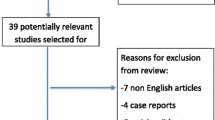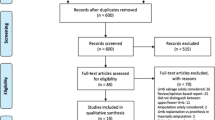Abstract
Aim
To analyze the functional outcomes between limb salvage and amputation patients who had multiple open injuries in the same lower limb.
Materials and Methods
This observational study analyzed 21 patients who were admitted with multiple open injuries in the same lower limb between January 2012 and December 2015 in our unit. Twelve patients underwent limb salvage and nine patients underwent amputation. The total number of surgeries, duration of hospital stays, ICU admission, complications, time to return to work and costs of inpatient treatment were analyzed. The functional outcome was assessed by using the lower extremity functional scale (LEFS) in both groups, SF-12 score was done for both groups and amputation specific scoring was done by using locomotors capabilities index (LCI).
Results
The LEFS was lower in salvage group than amputation group. The SF-12 score was close to normal population in the amputation group and was higher than salvage group. The duration of hospital stays, total number of surgeries and the costs of inpatient admission were higher in salvage group. The time to return to work was earlier in amputation group. Sixty-seven percentage of patients in the salvage group developed complications.
Conclusion
The functional outcome and SF-12 score was better in amputation group. Patients who had amputation returned to work earlier, had smaller number of secondary hospitalization and has less complications and incurred less expenditure for treatment. The treatment decision should be periodically reviewed when an initial choice of salvage is made. Amputation must be looked at as a treatment for early rehabilitation.
Similar content being viewed by others
References
Gopinathan, N. R., Santhanam, S. S., Saibaba, B., & Dhillon, M. S. (2019). Epidemiology of lower limb musculoskeletal trauma with associated vascular injuries in a tertiary care institute in India. Indian Journal of Orthopaedics. http://www.ijoonline.com/article.asp?issn=0019-5413;year=2017;volume=51;issue=2;spage=199;epage=204;aulast=Gopinathan. Accessed 27 May 2019.
Road accidents in India 2017. http://www.indiaenvironmentportal.org.in/files/file/road%20accidents%20in%20India%202017.pdf. Accessed 6 June 2019.
Shakti, G., Neel, B., Harnish, M., et al. (2019). Epidemiology and patterns of lower limb injuries at a tertiary care hospital in Ahmedabad. https://www.researchgate.net/publication/278847952_Epidemiology_and_patterns_of_lower_limb_injuries_at_a_tertiary_care_hospital_in_Ahmedabad. Accessed 27 May 2019.
Bosse, M. J., MacKenzie, E. J., Kellam, J. F., Burgess, A. R., Webb, L. X., Swiontkowski, M. F., et al. (2002). An analysis of outcomes of reconstruction or amputation after leg-threatening injuries. The New England Journal of Medicine, 347(24), 1924–1931.
Busse, J. W., Jacobs, C. L., Swiontkowski, M. F., Bosse, M. J., & Bhandari, M. (2007). Evidence-based orthopaedic trauma working group. Complex limb salvage or early amputation for severe lower-limb injury: a meta-analysis of observational studies. Journal of Orthopaedic Trauma, 21(1), 70–76.
Dagum, A. B., Best, A. K., Schemitsch, E. H., Mahoney, J. L., Mahomed, M. N., & Blight, K. R. (1999). Salvage after severe lower-extremity trauma: are the outcomes worth the means? Plastic and Reconstructive Surgery, 103(4), 1212–1220.
MacKenzie, E. J., Bosse, M. J., Kellam, J. F., Burgess, A. R., Webb, L. X., Swiontkowski, M. F., et al. (2002). Factors influencing the decision to amputate or reconstruct after high-energy lower extremity trauma. The Journal of Trauma, 52(4), 641–649.
Durham, R. M., Mistry, B. M., Mazuski, J. E., Shapiro, M., & Jacobs, D. (1996). Outcome and utility of scoring systems in the management of the mangled extremity. American Journal of Surgery, 172(5), 569–573. (Discussion 573–574).
Fodor, L., Sobec, R., Sita-Alb, L., Fodor, M., & Ciuce, C. (2012). Mangled lower extremity: can we trust the amputation scores? International Journal of Burns and Trauma, 2(1), 51–58.
Helfet, D. L., Howey, T., Sanders, R., & Johansen, K. (1990). Limb salvage versus amputation. Preliminary results of the Mangled Extremity Severity Score. Clinical Orthopaedics and Related Research, 256, 80–86.
Kumar, M. K., Badole, C., & Patond, K. (2007). Salvage versus amputation: utility of mangled extremity severity score in severely injured lower limbs. Indian Journal of Orthopaedics, 41(3), 183–187.
Ly, T. V., Travison, T. G., Castillo, R. C., Bosse, M. J., & MacKenzie, E. J. (2008). LEAP Study Group. Ability of lower-extremity injury severity scores to predict functional outcome after limb salvage. The Journal of Bone and Joint Surgery American, 90(8), 1738–1743.
Rajasekaran, S., Sabapathy, S. R., Dheenadhayalan, J., Sundararajan, S. R., Venkatramani, H., Devendra, A., et al. (2015). Ganga hospital open injury score in management of open injuries. European Journal of Trauma and Emergency Surgery, 41(1), 3–15.
Higgins, T. F., Klatt, J. B., & Beals, T. C. (2010). Lower Extremity Assessment Project (LEAP)–the best available evidence on limb-threatening lower extremity trauma. The Orthopedic Clinics of North America, 41(2), 233–239.
Rajasekaran, S., Naresh Babu, J., Dheenadhayalan, J., Shetty, A. P., Sundararajan, S. R., Kumar, M., et al. (2006). A score for predicting salvage and outcome in Gustilo type-IIIA and type-IIIB open tibial fractures. The Journal of Bone and Joint Surgery British, 88(10), 1351–1360.
Author information
Authors and Affiliations
Corresponding author
Ethics declarations
Conflict of Interest
The authors declare that they have no conflict of interest.
Ethical Standard Statement
This article does not contain any studies with human or animal subjects performed by the any of the authors.
Informed Consent
For this type of study informed consent is not required.
Additional information
Publisher's Note
Springer Nature remains neutral with regard to jurisdictional claims in published maps and institutional affiliations.
Rights and permissions
About this article
Cite this article
Govindaraju, S.K., Inja, D.B., Albert, S. et al. Multiple High-Energy Open Injuries in the Same Limb: Comparison of Outcomes Between Salvage and Amputation Groups. JOIO 55, 734–740 (2021). https://doi.org/10.1007/s43465-020-00311-3
Received:
Accepted:
Published:
Issue Date:
DOI: https://doi.org/10.1007/s43465-020-00311-3




